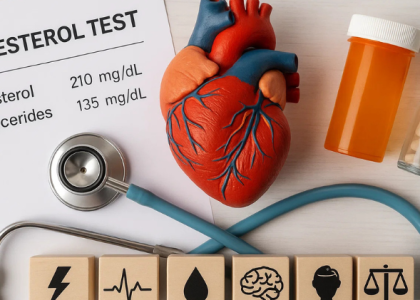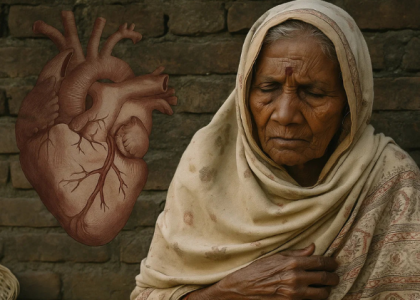FAQ: Why isn’t stroke mentioned more when discussing South Asian heart health?
Q: We often hear about heart attacks in South Asians, but what about stroke? Are we at risk for that too?
A: Yes, absolutely. South Asians are at heightened risk for both heart attacks AND strokes. Research shows that South Asians (people from India, Pakistan, Bangladesh, Nepal, Sri Lanka, Bhutan, and the Maldives) have higher rates of stroke compared to other ethnic groups, and often experience strokes at younger ages.
Studies show that South Asians develop stroke risk factors like diabetes, high blood pressure, and high cholesterol at lower body weights than other populations. This means even thin-looking South Asians can be at significant risk for stroke.
Q: Why don’t we hear about stroke as much as heart attacks when discussing South Asian health?
A: That’s an important question! There are a few reasons:
- Limited research focus: Until recently, most studies lumped all Asian groups together, hiding the specific risks for South Asians. As one cardiologist noted, “South Asians’ high risk of cardiovascular disease has been hidden by a lack of data.”
- Same root cause, different manifestation: Heart attacks and strokes are often discussed separately, but they’re actually “cousins” from the same family of cardiovascular disease. Both typically result from blocked arteries.
- Awareness gap: There’s still a significant knowledge gap about South Asian-specific risks, even among healthcare providers.
The good news is that awareness is growing. The MASALA study (Mediators of Atherosclerosis in South Asians Living in America) and other research initiatives are specifically looking at cardiovascular disease, including stroke, in South Asians.
Q: What exactly is a stroke? How is it related to heart health?
A: Think of stroke as a “brain attack” – similar to a heart attack, but occurring in the brain.
Here’s a simple way to understand it:
Both heart attacks and strokes happen when vital blood vessels become blocked or burst:
- Heart Attack: Blood flow to the heart muscle is blocked
- Stroke: Blood flow to part of the brain is blocked or a blood vessel in the brain bursts
[SUGGESTED DIAGRAM: Simple illustration showing two side-by-side images – one of a heart with a blocked artery, and one of a brain with a blocked artery. Caption: “Whether in the heart or brain, blocked arteries can cause serious damage.”]
The same risk factors that lead to heart disease also lead to stroke:
- High blood pressure
- High cholesterol
- Diabetes
- Inflammation
- Visceral fat (fat around organs)
This is why addressing your heart health also protects your brain!
Q: Are there specific types of stroke that South Asians are more prone to?
A: Research suggests South Asians have a higher prevalence of “small-artery occlusion” strokes, which involve blockages in the tiny blood vessels deep within the brain. These strokes are strongly linked to untreated high blood pressure and diabetes – two conditions that are very common among South Asians.
Studies have found that South Asian stroke patients tend to be younger and have higher rates of diabetes, blood pressure issues, and elevated blood glucose levels compared to other ethnic groups. This is similar to the pattern seen with heart disease in South Asians.
Q: What are the warning signs of stroke I should look out for?
A: Learning to recognize stroke symptoms could save your life or the life of a loved one. Remember the acronym BE FAST:
B = Balance: Sudden loss of balance or coordination E = Eyes: Sudden vision changes, blurriness, or loss of vision in one or both eyes F = Face: Facial drooping on one side; uneven smile A = Arms: Weakness or numbness in one arm; one arm drifts downward when both are raised S = Speech: Slurred speech, difficulty speaking, or trouble understanding speech T = Time: Time to call emergency services immediately!
If you notice any of these signs in yourself or someone else, call emergency services (911 in the US) right away. Note when symptoms first appeared – this information is crucial for treatment decisions.
Even if symptoms go away quickly, still seek immediate medical attention. This could be a TIA (transient ischemic attack) or “mini-stroke,” which often precedes a major stroke.
Q: My uncle walks daily and looks fit, but he still had a stroke. How is this possible?
A: This is a common and understandably confusing situation in South Asian families. Like heart attacks, strokes can affect people who appear thin and active on the outside. This ties back to the “thin-fat” phenotype often seen in South Asians.
While your uncle’s regular walking is excellent and definitely beneficial, South Asians can have:
- Hidden visceral fat – fat around internal organs that isn’t visible from the outside but can still cause inflammation and vascular damage
- Higher baseline risk factors – South Asians often develop insulin resistance, high blood pressure, and cholesterol issues at lower BMIs than other ethnic groups
- Genetic predisposition – family history plays a significant role in stroke risk, especially for South Asians
- Small vessel disease – damage to tiny blood vessels that may not be detected in routine testing
Remember, appearance can be deceiving. Even people who seem healthy can have invisible risk factors. This is why regular check-ups, including appropriate screening tests, are especially important for South Asians.
Q: Can stroke be prevented? What should South Asians do differently?
A: Yes! The good news is that up to 80% of strokes are preventable with the right approach. For South Asians, prevention might need to start earlier and be more proactive than for other populations.
Key prevention strategies include:
- Know your numbers: Get regular check-ups starting in your 30s or earlier if you have a family history. Pay special attention to:
- Blood pressure (aim for under 120/80)
- Blood sugar (fasting glucose and HbA1c)
- Cholesterol profile (including advanced lipid testing)
- Modify your diet: Traditional South Asian diets can be high in refined carbohydrates and unhealthy oils. Consider:
- Reducing white rice and refined flour portions
- Replacing ghee or coconut oil with olive or canola oil for some dishes
- Increasing vegetable portions and reducing sweets
- Moderating salt intake (critical for blood pressure control)
- Stay active: Regular exercise is crucial. Aim for:
- At least 150 minutes of moderate activity weekly
- Include both cardio (walking, dancing) and strength training
- Make it culturally enjoyable – Bhangra, garba, or Bollywood dancing counts!
- Manage stress: Chronic stress raises inflammation and blood pressure. Consider:
- Regular meditation or yoga
- Adequate sleep (7-8 hours)
- Community connections
- Take medications as prescribed: If your doctor has prescribed medications for blood pressure, cholesterol, or diabetes, taking them consistently is essential.
- Quit smoking and limit alcohol: Both significantly increase stroke risk.
Being proactive is especially important for South Asians due to our higher baseline risk.
Q: What should I do if I think someone is having a stroke?
A: Stroke is a medical emergency where every minute counts. If you suspect someone is having a stroke:
- Call emergency services immediately (911 in the US). Don’t drive them yourself – ambulance personnel can begin life-saving care immediately.
- Note the time when symptoms first appeared. This is critical information for determining treatment options.
- Check and monitor the person using the BE FAST method while waiting for help.
- Do not give them food, drink, or medication – they may have trouble swallowing.
- Keep them comfortable – help them lie down with their head slightly elevated.
- Stay with them and be reassuring until emergency help arrives.
Quick action can literally mean the difference between recovery and permanent disability – or even life and death.
Q: Final Thoughts: It’s Not Just About Weight, It’s About What’s Happening Inside
Just like heart disease, stroke risk in South Asians isn’t simply about weight or outward appearance. The same internal processes that put thin-looking South Asians at risk for heart attacks also increase our stroke risk:
- Visceral fat surrounding organs
- Inflammatory processes in blood vessels
- Insulin resistance
- Genetic factors
- Small vessel disease
By understanding these connections, South Asians can take charge of their cardiovascular health holistically – protecting both heart and brain. Awareness, early prevention, and prompt action when symptoms occur can save lives and preserve quality of life.
The higher risk South Asians face is concerning, but knowledge is power. With the right awareness and preventive steps, we can dramatically reduce both heart attack and stroke risk for ourselves and our families.
References
- PLOS One. “Risk Factors for Acute Stroke among South Asians Compared to Other Racial/Ethnic Groups.” https://journals.plos.org/plosone/article?id=10.1371/journal.pone.0108901
- American Heart Association. “South Asians’ high risk of cardiovascular disease has been hidden by a lack of data.” https://www.heart.org/en/news/2018/05/29/south-asians-high-risk-of-cardiovascular-disease-has-been-hidden-by-a-lack-of-data
- Circulation. “Atherosclerotic Cardiovascular Disease in South Asians in the United States: Epidemiology, Risk Factors, and Treatments.” https://www.ahajournals.org/doi/full/10.1161/CIR.0000000000000580
- American Stroke Association. “Stroke Symptoms and Warning Signs.” https://www.stroke.org/en/about-stroke/stroke-symptoms
- UT Southwestern Medical Center. “What we know – and don’t – about South Asians’ heart disease risk.” https://utswmed.org/medblog/what-we-know-and-dont-about-south-asians-heart-disease-risk/
- Harvard Health. “How to recognize and respond to a ‘warning’ stroke.” https://www.health.harvard.edu/heart-health/how-to-recognize-and-respond-to-a-warning-stroke
- Centers for Disease Control and Prevention. “Signs and Symptoms of Stroke.” https://www.cdc.gov/stroke/signs-symptoms/index.html
- Cleveland Clinic. “Stroke: What It Is, Causes, Symptoms & Treatment.” https://my.clevelandclinic.org/health/diseases/5601-stroke
- ScienceDirect. “An Examination of Stroke Risk and Burden in South Asians.” https://www.sciencedirect.com/science/article/abs/pii/S1052305717302100




